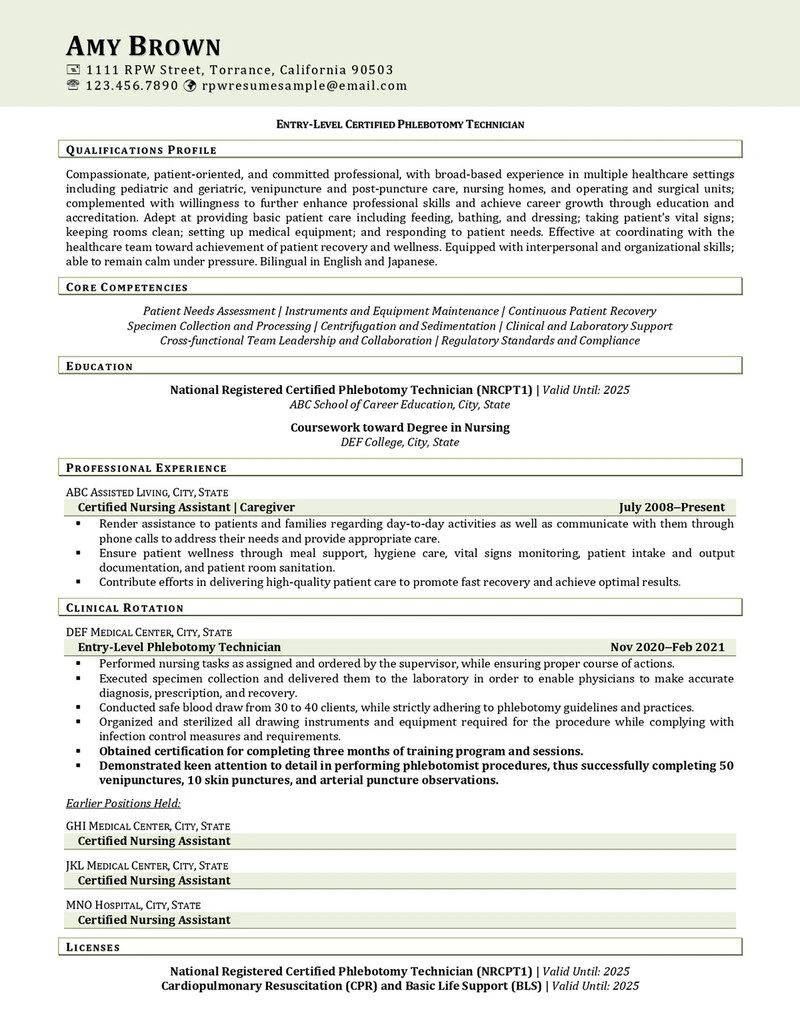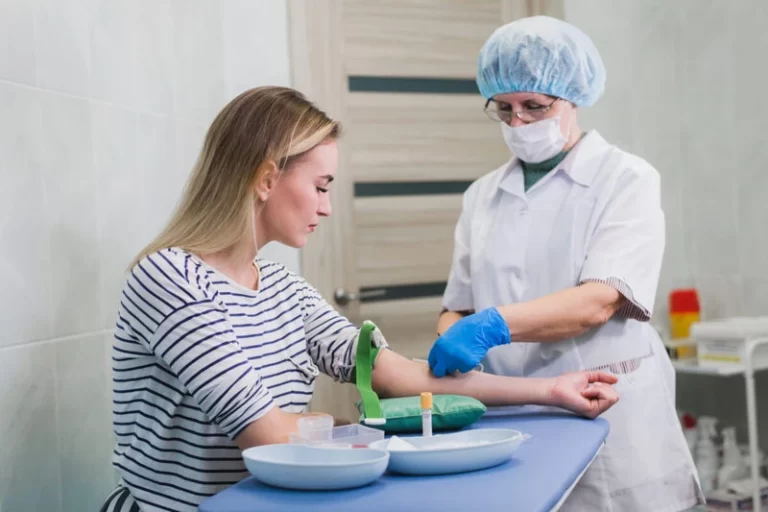In a report published by the United States Bureau of Labor Statistics, job opportunities for phlebotomists are estimated to increase by 10% from 2021 to 2031. This is faster than the average for all professions. In addition, approximately 21,500 job openings for such positions are anticipated over the decade.
With these figures, it’s crucial that you step up your game if you wish to be part of this noble profession. To start, you’d need a phlebotomist resume that showcases why you’re the perfect fit for the role and what you can contribute to their organization.
In this article, we’ll give you an overview of phlebotomists, including their roles and steps to become one. Plus, we’ll share with you surefire tips on what to include and how to write an interview-generating phlebotomist resume and example to help you land this job. Read on.
What is a Phlebotomist?
Phlebotomists are medical professionals who are primarily responsible for performing blood draws on patients and blood donors for medical testing, transfusions, or donations. They are trained to collect blood samples through venipuncture, finger pricks, or heel pricks for infants.
Phlebotomists are experienced and efficient in different work settings, including assisted-living facilities, diagnostic laboratories, blood donation centers, hospitals, clinics, and outpatient care centers. They work closely with other healthcare professionals such as supervising physicians, nurses, and laboratory technicians.
What are the Duties of a Phlebotomist?
Aside from the primary duties mentioned above, phlebotomists also fulfill a wide array of tasks on a daily basis. These include the following:
- Prepare patients for blood draws, which involve putting them at ease;
- Validate patients’ identity before performing blood draws, while guaranteeing proper labeling of collection vials;
- Offer assistance to patients who experience adverse reactions after performing blood draw or transfusion;
- Maintain sanitary work areas by complying with all health and safety protocols and procedures;
- Choose gauge needles and prepare veins or fingers for blood draw;
- Collect different medical testing materials, such as blood storage bags, needles, sample vials, and test tubes;
- Perform data entry including encoding bloodwork information into medical records;
- Provide diagnostic notes to physicians, other healthcare professionals, and hospitals;
- Sterilize and calibrate laboratory equipment used in drawing and testing blood specimens; and
- Maintain, monitor, and store blood samples for delivery to testing laboratories or blood banks.
Expert Tip:
You may want to include these job descriptions in your phlebotomist resume to increase your chances of getting hired.
How Do You Become a Phlebotomist?
Below is a step-by-step guide in order to become a phlebotomist. However, it’s important to note that the requirements vary from state to state:
- Earn high school diploma or general educational development (GED) certificate;
- Apply to and complete an accredited phlebotomy program;
- Obtain a phlebotomy certification, which includes Limited Phlebotomy Technician (LPT), Certified Phlebotomy Technician I (CPT I), and Certified Phlebotomy Technician II (CPT II);
- Take the certification examination.
Apart from these, phlebotomists must be equipped with knowledge of proper patient identification methods, effective puncture techniques, and legal requirements about drawing blood and handling fluid samples. Plus, they should possess excellent communication skills, attention to detail, and the ability to connect with patients with diverse backgrounds.
Expert Tip:
Include these in your phlebotomist resume if you have such qualifications. This will help you ace the screening process, especially if these are mentioned in the job posting.
What to Include in Your Phlebotomist Resume
Before landing a job as a phlebotomist, you’ll need a resume that will showcase why you’re the perfect candidate for the position. That said; it’s crucial that your job search tool must contain all the important elements.
Without further ado, here are the details that you should include in your phlebotomist resume to effectively grab the hiring managers’ attention and pass the applicant tracking system (ATS).
Contact Information
Starting at the header of your job application document, write your full name, complete mailing address, active mobile number, and email address. You may also put your licenses or certifications relevant to your target job position beside your name, as well as your LinkedIn profile URL, if there are any.
Before sending your resume to healthcare institutions, make sure to double-check your details. Doing so will help you avoid missing job interview invites.
Specific Target Job Position
Stating your target role in your phlebotomist resume lets the hiring managers know what position you want to apply for. Additionally, your target job position serves as a keyword that’s integral when screened by ATS.
Qualifications Profile/Summary of Qualifications
Since hiring managers spend only an average of seven seconds reviewing a resume, it’s paramount that you highlight what you can bring to the table. Make your resume summary more attention-grabbing by mentioning your expertise, experience, qualifications, and best feats in a brief and concise way.
Expert Tip:
To keep the hiring managers engaged in reading your phlebotomist resume, create striking resume titles and headlines instead of writing a resume objective-type statement.
List of Phlebotomist Skills
When presenting your skills in your job search document, make sure to include both your soft and hard skills. These will help you not only catch the attention of hiring managers but also beat the bots. Plus, it can boost your chances of getting moving forward to the next hiring process.
Here are some of the skills you should put on your phlebotomist resume to ace your job search.
Soft skills:
- Attention to detail
- Communication and interpersonal
- Dexterity
- Adaptability
- Critical thinking
- Data entry
- Stress management
Hard skills:
- Patient preparation
- Sample collection and management
- Population-specific procedures
- Venipuncture
- Specimen labeling
- Color chemical reactions reading
- Medical coding
Related Article:
Ways to List and Create Headings for Job Skills in a Resume and 8 Essential Job Skills to Include in Your Resume
Work Experience
This is one of the most important sections that hiring managers review in your document. Hence, make sure that your work history highlights not only your job descriptions but also your accomplishments and contributions. This core part also allows them to gauge whether you have experience relevant to the job you’re applying for.
As you present your work experience section, start with your most recent job down to your first position. Include the company names and their locations, your specific job titles, and employment dates. When presenting your duties and responsibilities, contributions, and achievements, use bullet points instead of paragraph style for easy reading.
Related Article:
The Ultimate Guide to Writing a Resume with No Work Experience
Education
While a degree is not required to become a phlebotomist, it’s still important that you impress the employers with your academic background. Nonetheless, if you took and completed a medical-related degree, don’t forget to include this in your resume as it adds value to your application.
Certifications, Licenses, and Training
As mentioned above, certification in phlebotomy is one of the requirements to pursue a career as a phlebotomist. So if you’ve earned such certifications, write them down to showcase that you’re a certified phlebotomist.
Furthermore, if you’ve participated in and completed phlebotomy programs, including them in your resume can boost your chances of getting the hiring managers’ affirmative response.
Other Optional Sections to Include in a Phlebotomist Resume
Aside from the main resume sections above, you might also consider adding your professional organization, activities or community involvement, or technical skills. These can set you apart from other job hopefuls and take you to the next hiring stage.
How to Write Your Phlebotomist Resume
Now that you have an idea about the important sections to include in your phlebotomist resume, are you ready to craft your own job search tool? Fret no more! Below are some surefire tips to heed in writing your resume. Read on.
1. Use a simple yet attention-grabbing design and layout.
Apart from the content of your resume, it’s worth noting that resume design and layout also add credence to your job application tool. That said; avoid applying decorative designs, fancy font styles, and too much borders. You can actually outshine other job candidates with an easy-to-read document that highlights your best feats.
2. Choose the right resume format.
Resume formats play a vital role in showing off an applicant’s overall qualifications, background, skills, expertise, and experience. Plus, this lets employers assess and identify if you’re qualified for the job. Hence, make sure to use a resume format that can speak of your qualities as a phlebotomist.
Related Article:
3. Showcase your phlebotomist skills.
To effectively earn the hiring managers’ affirmative response, you must underscore your skills and abilities related to phlebotomy. Furthermore, including your soft skills can add value to your job application.
4. Use resume keywords and action verbs.
Today’s companies use ATS to easily screen resumes. Thus, incorporating resume keywords in your tool is highly suggested. Why? Because such industry-specific terms help the bots and hiring managers evaluate if you’re the one they are looking for.
On the other hand, make your phlebotomist resume more striking and action-oriented by using action verbs when listing your job duties, accomplishments, and contributions.
5. Review, proofread, and edit your phlebotomist resume.
Finally, don’t forget to review your job search tool multiple times before submitting to your target employers. This will help you determine and correct grammar, spelling, and punctuation mistakes. You might also consider asking for someone’s help to proofread your resume to make sure that it is free from errors.
Expert Tip:
If you’re looking for professional resume feedback, we’ve got your back! We offer free resume review to assist you in improving your job search document.
Phlebotomist Resume Example
Below is a phlebotomist resume example to guide you in crafting your own job search tool. Review and take note of how one of our expert resume writers highlighted the skills and qualifications by applying the tips mentioned above.

Note: Check out our healthcare resume examples for more ideas.
Win Your Job Search with the Help of Our Phlebotomist Resume Experts
Save your time and energy from doing this daunting task and focus on preparing for your job interview! Let our professional resume writers help you craft your job-winning phlebotomist resume.
At Resume Professional Writers, we take pride not only in housing the best resume writers and career coaches, but also in providing high-quality resume writing services. Contact us today and get ready to ace your job search.





